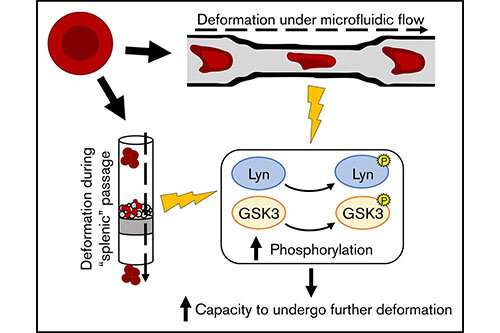Putting the squeeze on red blood cells

For the first time, researchers at the University of Bristol's Blood and Transplant Research Unit, and the French National Institute for Blood Transfusion, have captured the moment a red blood cell is "squeezed" while recording the changes that allow it to deform and subsequently recover its shape.
The study, published in Blood Advances, was funded by the European Union's Horizon 2020 research and innovation program, NHS Blood & Transplant and through funding from the National Institute for Health Research (NIHR) for the University of Bristol's Blood and Transplant Research Unit, focusing on red blood cell products.
Joint senior author Dr. Tim Satchwell explains:
"Every day, each red blood cell performs roughly 1,400 full circuits through the heart and around the body. During these circuits, the cell must repeatedly squeeze through incredibly small capillaries (less than half its size) in the organs and brain to deliver oxygen before assuming its recognizable biconcave shape. Prior to this research, no-one knew exactly how this very simple but important cell can adapt to survive those shape changes and remain fully functional throughout its normal lifecycle of 120 days. With this study, we have been able to capture this process for the first time."
It is incredibly difficult to study the moment a red blood cell squeezes due to how small the cell is and how quickly the cells deform. To achieve this, the scientists combined the use of sensitive mass spectrometry (to detect specific protein changes) with two ways to "squeeze" the cells. One method trapped the cells in a layer of tiny metal spheres and the other used tiny microcapillary channels built into a microscope slide in combination with an extremely fast camera.
The researchers have built the first map of changes that occur in the deforming red blood cell and showed that two specific proteins (which are protein kinases) are needed to allow the cells to deform and recover from squeezing. If one protein alone is stopped from working, this affects the cell's ability to squeeze and recover; and if both proteins are stopped, the cell doesn't squeeze at all and gets stuck.
Joint senior author Dr. Ashley Toye, Director of the NIHR Blood and Transplant Research Unit at the University of Bristol, said:
"This study showcases how the simple red blood cell undergoes complex changes to adapt to being squeezed in the capillaries of the body and serves as an important platform to answer further questions: do the cells react differently in disease? Do certain people have 'super squeezable' cells? What is the function of the remaining changes that were detected? Could different combinations of drugs used to treat medical conditions affect how red blood cells deform?"
The next step for the researchers is to attempt to answer these questions by characterizing the deforming red blood cell through the newly uncovered signaling pathways. For now, one thing is certain: the red blood cell is not as simple as previously thought.
More information: Pedro L. Moura et al. Reticulocyte and red blood cell deformation triggers specific phosphorylation events, Blood Advances (2019). DOI: 10.1182/bloodadvances.2019000545



















